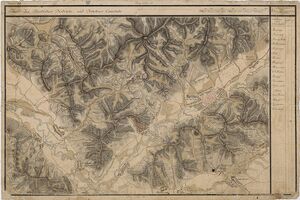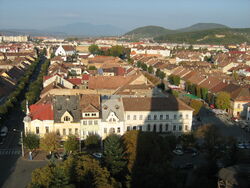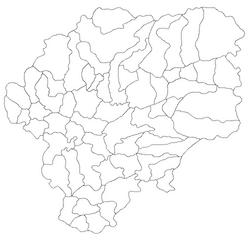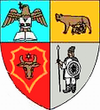| Main | Births etc |
|---|
| Bistrița German: Bistritz, archaic Nösen Hungarian: Beszterce |
|||
|---|---|---|---|
| — City — | |||
| View of Bistrița | |||
|
|||
| Location of Bistrița in Romania | |||
| Coordinates: | |||
| Country | |||
| County | |||
| First mentioned | 1264 | ||
| Subordinated villages | |||
| Government | |||
| • Mayor | Ovidiu Crețu (USL) | ||
| Area | |||
| • Total | 145.47 km2 (56.17 sq mi) | ||
| Elevation | 356 m (1,168 ft) | ||
| Population (2011) | |||
| • Total | 75 076 | ||
| • Density | 516.09/km2 (1,336.7/sq mi) | ||
| Time zone | EET (UTC+2) | ||
| • Summer (DST) | EEST (UTC+3) | ||
| 420000 - 420199 | |||
| Website | http://www.primariabistrita.ro/ | ||
Bistrița (German: Bistritz, archaic Nösen;[1] Hungarian: Beszterce) is the capital city of Bistrița-Năsăud County, in northern Transylvania, Romania. It was located within Hungary until 1918 and between 1940 and 1944. It is situated on the Bistrița River. The city has a population of approximately 70,000 inhabitants, and it administers six villages: Ghinda, Sărata, Sigmir, Slătinița, Unirea and Viișoara.
Etymology[]
The town was named after the Bistriţa River, whose name comes from the Slavic word bystrica meaning "fast-moving water".
History[]
The earliest sign of settlement in the area of Bistriţa is in Neolithic remains. The Turkic Pechenegs settled the area in 12th century following attack from Cumans. Transylvanian Saxons settled the area in 1206 and called the region "Nösnerland". A large part of settlers were fugitives, convicts and poor people looking for lands and opportunities.[2] The destruction of Markt Nosa ("Market Nösen") under the Mongols of central Europe is described in a document from 1241. Situated on several trade routes, Bistriţa became a flourishing medieval trading post.
Bistriţa became a free royal town in 1330. In 1353 it gained the right to organize an annual 15-day fair, as well as a seal containing the coat of arms of an ostrich with a horseshoe in its beak. In 1465, the city's fortifications had 18 defensive towers and bastions defended by the local guilds. It was also defended by a Kirchenburg, or fortified church. The town was badly damaged by fire five times between 1836 and 1850.[3] The church suffered from fire in 1857, when the tower's roof and the bells were destroyed. The roof was rebuilt after several years. Fires in the nineteenth century also destroyed much of the city's medieval citadel.
A Jewish community developed in Bistriţa after the prohibition on Jewish settlement there was lifted in 1848. The community was Orthodox with a strong Hasidic section, but there were also Jews who adopted German and Hungarian culture. A Zionist youth organization, Ivriyah, was founded in Bistriţa in 1901 by Nissan Kahan, who corresponded with Theodor Herzl and there was significant support for the Zionist movement in the town between the two world wars. A large yeshivah flourished under the direction of the rabbi of Bistriţa, Solomon Zalman Ullmann, in the first part of the twentieth century.[4]
The city was part of the Austro-Hungarian Empire until 1918. On December 1 that year, Transylvania united with Romania, and Romanian Army troops entered Bistrița on December 5.[5] the reverted briefly to Hungarian control between 1940 and 1944 and was reintegrated into Romania after World War II.[4]
World War II[]
During World War II, the Hungarian authorities deported several dozen Jewish families in 1941 from Bistriţa to Kamenets-Podolski in the Ukraine, where they were killed by Hungarian soldiers. The Jews of Bistriţa, as elsewhere in Hungary, were subjected to restrictions, and Jewish men of military age were drafted for forced labor service. In May 1944, the Jewish population was forced into the Bistrița ghetto, set up at Stamboli Farm, about two miles from the city. The ghetto consisted of a number of barracks and pigsties. At its peak, the ghetto held close to 6,000 Jews, including those brought in from the neighboring communities in Beszterce-Naszód County. Among these were the Jews of Borgóbeszterce, Borgóprund, Galacfalva, Kisilva, Marosborgó, Nagyilva, Nagysajó, Naszód, Óradna, and Romoly. The ghetto was liquidated with the deportation of its inhabitants to Auschwitz in two transports on June 2 and June 6, 1944.[4][6]
Recent events[]
On June 11, 2008, the tower and roof of the church caught fire when three children who went to steal copper set it on fire while playing.[7] The main part of the church suffered just a little damage and is not in much danger, the interior being intact. It is speculated that both bells residing in the tower (one dating from the 15th century, the other from the 17th) might have melted.
Demographics[]
| Historical population | ||
|---|---|---|
| Year | Pop. | ±% |
| 1891 | 9,100 | — |
| 1900 | 12,155 | +33.6% |
| 1912 | 13,236 | +8.9% |
| 1930 | 14,128 | +6.7% |
| 1941 | 16,282 | +15.2% |
| 1948 | 15,801 | −3.0% |
| 1956 | 20,292 | +28.4% |
| 1966 | 25,519 | +25.8% |
| 1977 | 44,339 | +73.7% |
| 1992 | 87,710 | +97.8% |
| 2002 | 81,467 | −7.1% |
| 2004 | 82,400 | +1.1% |
| 2011 | 70,493 | −14.5% |
| Source: Census data, Encyclopedia Judaica | ||
The population of the city numbered 9,100 in 1891, of whom 718 (8%) were Jews; 12,155 in 1900 of whom 1,316 (11%) were Jews; 14,128 in 1930 of whom 2,198 (16%) were Jews; and 16,282 in 1941 of whom 2,358 (14%) were Jews. 1,300 Jews resettled in Bistriţa in 1947 and included survivors from the camps, former residents of neighboring villages, and others liberated from the Nazi concentration camps. The Jewish population declined steadily as a result of emigration to Israel, the United States, and Canada. By 2002, only about 15 lived in the city.[4]
According to the last census, from 2011, there were 70,493 people living within the city of Bistriţa,[8] making it the 30th largest city in Romania. The ethnic makeup was as follows:
- Romanians: 64,214 (91.09%)
- Hungarians: 4,109 (5.82%)
- Gypsies: 1,644 (2.33%)
- Germans (Transylvanian Saxons): 304 (0.43%)
- Other: 0.16%

Bistrița 1911
Main sights[]

Bistrița in the Grand Duchy of Transylvania maps, 1769-1773. Josephinische Landesaufnahme
The main attraction of Bistriţa's central square is the Lutheran church, which was built by the Transylvanian Saxons and originally constructed in the 14th century in Gothic style but later remodeled between 1559–1563 by Petrus Italus with Renaissance features. It was renovated in 1998.
The Bistriţa-Năsăud County Museum, located in a former barracks, contains Thracian, Celtic, and German artifacts.
Popular culture[]
In Bram Stoker's novel Dracula, the character Jonathan Harker visits Bistriţa and stays at the Golden Krone Hotel (Romanian: Coroana de Aur). Although no such hotel existed when the novel was written, a hotel of the same name has since been built for tourists.
In the PlayStation 2 game Shadow Hearts, Bistriţa (where it is spelled "Biztritz") was a major place and home to the role-playing character Keith Valentine.
Transportation[]
The major cities directly linked by trains to this city are Bucharest via a night train, and Cluj-Napoca via several trains. Access from Bistriţa to major railway lines is generally through connections in Dej or Beclean, although some other trains stop at the nearby railway junction of Sărăţel.
Bistriţa also serves as a midway point for C&I, a transport service, and is a changing point for people traveling between Suceava, Satu Mare, Cluj-Napoca, Sibiu, Sighişoara, Târgu Mureş, and Braşov.
Nearest airport is Cluj-Napoca Airport, which is located 110 kilometres (68 miles). from Bistriţa.
Tourism[]
- Arcalia Dendrological Park (17 km (11 mi) from Bistriţa) it hosts over 150 species of trees (Japanese acacia, silver fir trees, Caucasian spruce fir)
- Colibita Lake (artificial dam, situated in Bargau Mountains)
- Lakes Lala Mare and Lala Mic (glacier lakes, below Ineu top)
Natural reservations[]
- National Park in the Rodna Mountains (37,429 ha in Bistriţa – Nasaud county)
- Piatra Corbului – “Raven’s Rock” – (geological and vegetal park, situated in Calimani Mountains)
- The Salt Mount in Saratel
- Tausoare Cave (the deepest cave in Romania – 478.5 m)
Resorts[]
- Sângeorz–Băi (balneo – climatic resort, situated in Rodna Mountains, approx. 55 km (34 mi) from Bistriţa)
- Colibița (approx. 50 km (31 mi) from Bistriţa)
- Piatra Fantanele (approx. 60 km (37 mi) from Bistriţa, at an altitude of 1,100 m (3,608.92 ft) – Tihuta Pass)
- Valea Vinului – Wine Valley – (approx. 90 km (56 mi) from Bistriţa)
Museums and exhibitions[]
- Transylvanian Saxons’ Museum - Livezile
- Museum of Contemporary Art – Sangeorz-Bai
- Andrei Muresanu Memorial House – Bistriţa
- Liviu Rebreanu Memorial House – Liviu Rebreanu village
- Silversmith’s House – Bistriţa
- George Cosbuc Memorial House – Cosbuc village
- Ion-Pop Reteganul Memorial House – Reteag village
Natives[]
- Gavril Bănulescu-Bodoni (1746-1821), bishop
- Arnold Graffi (1910–2006), doctor
- Anita Hartig (born 1983), operatic soprano
- Andrei Mureşanu (1816–1863), writer of the Romanian national anthem
- Max Speter (1883-1942), chemist and science historian
- Gabriela Szabo (born 1975), track and field athlete
Sport[]
Teams[]
- Gloria Bistriţa playing in Romania's LIGA 2 soccer league, Liga II
- CSH 2009 Bistriţa playing in Romania's Divizia A Masculin Seria B, Romanian Handball Federation
- CSM Bistriţa playing in Romania's Divizia A Feminin Seria B, Romanian Handball Federation
Natives[]
- Maria Bosi
- Adrian Crișan
- Corina Dumbrăvean
- Kalinikos Kreanga
- Viorel Moldovan
- Valeria Motogna-Beșe
- Remus Nicolai
- Mihaela Purdea
- Lucian Sânmărtean
- Mihaela Ani Senocico
- Gabriela Szabo
- Bernadette Szőcs
International relations[]
Twin towns - sister cities[]
Bistriţa is twinned with:
|
References[]
- ^ Siebenbürgen Village List. Retrieved 11 January 2007.
- ^ K. Gündisch, Transylvania and the Transylvanian Saxons. Langen-Müller, Munich, ISBN 3784426859
- ^ Leslie S. Klinger, The New Annotated Dracula, W. W. Norton, 2008
- ^ a b c d Marton, Yehouda; Schveiger, Paul and Braham, Randolph (2007). "Bistrita". Encyclopedia Judaica. 2 (2nd ed.).
- ^ (Romanian) Florina Pop, "Bistriţa: Fotografie unicat din decembrie 1918", Adevărul, December 1, 2010; accessed September 26, 2013
- ^ Braham, R.L (2000). Politics of Genocide: The Holocaust in Hungary. Wayne State University Press. ISBN 0814326919.
- ^ "Három roma kiskorú gyújtotta fel a besztercei templom tornyát - Körkép - Gyorshírek - Szabadság". Szabadsag.ro. 2008-06-23. http://www.szabadsag.ro/szabadsag/servlet/szabadsag/template/news%2CPQuickNewsScreen.vm/id/2809. Retrieved 2013-03-26.
- ^ "Ethno-demographic Structure of Romania". The Ethnocultural Diversity Resource Center. http://www.edrc.ro/recensamant.jsp?regiune_id=2140&judet_id=2237&localitate_id=2238. Retrieved January 2, 2011.
- ^ "Zielona Góra Miasta partnerskie". Urząd Miasta Zielona Góra. http://www.zielonagora.pl/PL/1111/#. Retrieved 2013-06-24.
- This article incorporates information from the revision as of 11 January 2007 of the equivalent article on the German Wikipedia.
External links[]
| ||||||||

|
Dumitra | Feldru | Livezile | 
|
| Șintereag | Cetate | |||
 Bistrița | ||||
| Șieu-Măgheruș | Mărișelu | Budacu de Jos |
| |||||||||||||
| |||||||
| This page uses content from the English language Wikipedia. The original content was at Bistrița. The list of authors can be seen in the page history. As with this Familypedia wiki, the content of Wikipedia is available under the Creative Commons License. |




